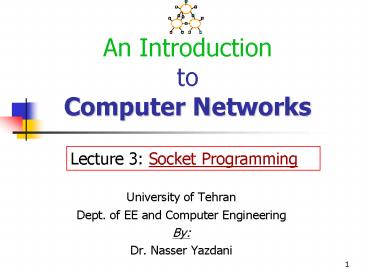An Introduction to Computer Networks - PowerPoint PPT Presentation
1 / 16
Title:
An Introduction to Computer Networks
Description:
An Introduction to Computer Networks Lecture 3: Socket Programming University of Tehran Dept. of EE and Computer Engineering By: Dr. Nasser Yazdani * – PowerPoint PPT presentation
Number of Views:63
Avg rating:3.0/5.0
Title: An Introduction to Computer Networks
1
An Introduction to Computer Networks
Lecture 3 Socket Programming
- University of Tehran
- Dept. of EE and Computer Engineering
- By
- Dr. Nasser Yazdani
2
Outline
- Socket programming
- What is a Socket?
- Why do we need sockets?
- Types of sockets
- Uses of sockets
- Example applications
- Code
3
Socket programming
- Goal- Communication between two processes
- They use interface/services from the transport
layer. The interface is called Application
Programming Interface, API.
Server process
Client process
TCP/UDP
TCP/UDP
Socket API
IP
IP
Ethernet Adaptor
Ethernet Adaptor
4
What are Sockets?
- It is an API between applications and network
- protocol software provided by the OS Functions it
provides - Define an end- point for communication
- Initiate and accept a connection
- Send and receive data
- Terminate a connection gracefully
- Supports multiple protocol families
- Examples Unix inter- process communication,
TCP/ IP - Only Internet sockets will be covered in this
lecture - Berkeley Sockets are the most common (from BSD
- Unix)
5
Type of Sockets
- Two different types of sockets
- stream vs. datagram
- Stream socket ( a. k. a. connection- oriented
socket) - It provides reliable, connected networking
service - Error free no out- of- order packets (uses
TCP) - applications telnet/ ssh, http,
- Datagram socket ( a. k. a. connectionless
socket) - It provides unreliable, best- effort networking
service - Packets may be lost may arrive out of order
(uses - UDP)
- applications streaming audio/ video
(realplayer),
6
Socket usages
- Network applications use sockets at some level,
often using higher level protocols on top of
sockets - File transfer apps (FTP), Web browsers (HTTP),
Email (SMTP/ POP3), etc - Simplify and expedite application development
process - Most exploits client-server model.
7
A generic server (FTP)
- Wait for connections on a port
- When a client connection comes in,
- loop
- Read in the clients request
- Read data from a file
- Send the data to the client
- Disconnect when we have reached EOF
8
A generic client, high level
- Connect to a given server
- loop
- Send a request to the server
- Read servers response
- Read servers data
- Disconnect when we have reached EOF
9
Client- Server communication (TCP)
server
bind() to a receiving port
Accept() connection
socket()
listen () to socket
send() recv()
client
bind() to any port
send() recv()
socket()
connect () to server
10
Socket
- Transport protocol needs the following
information for multiplexing/demultiplexing. - (source port, source address, destination port,
destination address) - Socket- the end point of connection. Process
read/write from/to socket. A socket is specified
by a socket descriptor. - struct sockaddr_in
- u_char sin_family / Address Family /
- u_short sin_port / Port number /
- struct in_addr sin_addr / IP address /
- char sin zero8 / unused /
11
TCP Server program
- Make a socket
- include ltsys/ types. hgt
- include ltsys/ socket. hgt
- int fd, newfd, nbytes, nbytes2
- char buf512, response512
- struct sockaddr_in srv
- fd socket(AF_INET, SOCK_STREAM, 0)
12
TCP Server program
- The socket was created now bind it to a port and
host. - srv.sin_family AF_INET
- srv.sin_port htons(80)
- srv.sin_addr.s_addr inet_addr(128.2.15.9'')
- bind(fd, (struct sockaddr) srv, sizeof(srv))
- Now sit and listen
- listen(fd, 5)
- Now, accept any connection. First, clear the
structure. - struct sockaddr_ in cli
- int cli_ len
- memset( cli, 0, sizeof( cli)) / clear it /
- newfd accept(fd, (struct sockaddr) cli, cli
len)
13
TCP Server program
- Now it can read from socket, newfd, and write to
socket, newfd. - int BUF_ SIZE 1024, bytesrecv 0
- char buf BUF_ SIZE
- / receives up to BUF_ SIZE bytes from sock and
stores them in buf. / - bytesrecv recv( newfd, buf, BUF_ SIZE, 0)
- / send up BUF_ SIZE bytes /
- bytesrecv send( newfd, buf, BUF_ SIZE, 0)
- At the end, we need to close both sockets by
close command. - close( newfd) / closes the socket newfd /
14
TCP client program
- int fd, newfd, nbytes, nbytes2
- char buf512, response512
- struct sockaddr_in srv
- fd socket(AF_INET, SOCK_STREAM, 0)
- The same as server. Now, it needs to connect to
server. - srv.sin_family AF_INET
- srv.sin_port htons(80)
- srv.sin_addr.s_addr inet_addr(128.2.15.9'')
- connect(fd, (struct sockaddr) srv,
sizeof(srv)) - Connect is blocking and send a SYN signal and is
blocked until receive SYNACK, (three way
handshaking) - It can start now reading and writing
- sprintf(request, Here's my request'')
- nbytes2 write(fd, request, strlen(response))
- close(fd)
15
Client- Server communication (UDP)
server
recvfrom () sendto()
bind() to a receiving port
socket() to create socket
client
socket() to create scoket
recvfrom () sendto ()
bind() to any port
16
UDP Server/client program
- / fill in declarations /
- fd socket(AF_INET, SOCK_DGRAM, 0)
- The socket was created now bind it to a port and
host exactly the same way as TCP. - Now listen no connection, start reading from the
port by - nbytes recvfrom(fd, buf, sizeof(buf), 0,
(struct sockaddr) cli, cli len) - UDP client is the same TCP, except instead of
read/write, it uses - nbytes sendto(fd, request, sizeof(request), 0,
(struct sockaddr) srv, sizeof(srv))








![Introduction to Artificial Neuron Networks [ANN] PowerPoint PPT Presentation](https://s3.amazonaws.com/images.powershow.com/6292342.th0.jpg?_=20150319091)






















